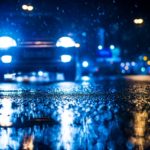Your vehicle’s headlights ensure that you can see what’s ahead of you when driving at night or during a foggy day. It’s important to learn which headlight colors are road legal to prevent traffic violations or accidents.
Is It Illegal To Have Colored Headlights?
Over the years, headlight colors have become a controversial topic among vehicle owners because of how popular colored headlights are despite the safety issues they pose. Colorful custom lighting might seem like a fun idea, but it isn’t actually legal.
Colored headlights at shows and events are okay, but they aren’t allowed on the road. All US states require legal headlights to be either white or amber. This is because colored headlights like blue headlights can block another driver’s field line of sight when the headlights are angled too high from improper installation. Blue headlights can also produce an unpleasant glare.

Are Blue Headlights Legal?
You might be wondering why you still see vehicles with blue headlights on the road if colored headlights are illegal. Most vehicles don’t actually have blue headlights. Instead, they have bright headlights that give off a faint blue tint. These headlights can be high-intensity discharge (HID), light-emitting diode (LED), or xenon gas headlights, and they’re legal as long as they’re original equipment manufacturer (OEM) parts.
According to Federal Motor Vehicle Safety Standards (FMVSS) 108, you can’t modify your vehicle’s headlights. You can only replace broken headlights with the same model that your vehicle originally had. In short, blue headlights that originally came with the vehicle are legal, while blue headlights from modifications are illegal.
Are Red Headlights Legal?
In most states, civilian owners aren’t allowed to have any type of red light on their vehicle. This is because only emergency vehicles, such as ambulances, fire trucks, and police cars, can have red lights. Emergency lights usually come in red and blue, and they alert other drivers on the road of the emergency vehicle’s nearby presence. For this same reason, flashing lights are also prohibited in most states.

Other Laws Regarding Headlights
Like most traffic regulations, laws regarding headlights vary from state to state. However, there are some general reminders you should keep in mind.
DOT-Approved Headlights
You might have noticed some headlight conversion kits come with a Department of Transportation (DOT)-Approved or DOT-Certified label. This can confuse some vehicle owners into thinking that modifying one’s headlights is legal because the kit is “DOT-Approved”. However, while these products might be of good quality, there’s no actual guarantee that they meet the Department of Transportation’s requirements.
A DOT-Approved logo only means that the manufacturers followed the requirements set by the DOT, but the DOT doesn’t actually approve them. Because of this, it’s best to be extra careful when replacing your headlights.

Brightness
The primary function of a headlight is to illuminate the driver’s way, so most drivers want their headlights to be as bright as possible. However, there’s actually a legal limit on how bright headlights can be. According to the Code of Federal Regulations, headlights must be 500 to 3,000 candelas. Any brighter than that can blind other drivers on the road and cause traffic accidents.
Height
Aside from color and brightness, road-legal headlights should also have a specific height. Most states have a height requirement for headlights to ensure that they aren’t too low to limit the driver’s eyesight and aren’t too high to disrupt another driver’s vision. Headlights are measured from the ground to the center of the lowest bulb of the vehicle’s headlight.
Most states require headlights to be 24 to 54 inches from the ground. However, California allows a 22-inch minimum height for headlights. Meanwhile, Colorado only specifies a maximum height of 44 inches with no minimum. The specific requirements differ per state, so be sure to check your home state’s laws for more information.
Driving With Broken Headlights
All 50 states prohibit driving with broken headlights. Except for motorcycles, all vehicles should have at least two functioning headlights. The specific laws differ per state, but driving with busted headlights will usually cost you a fix-it ticket and a fine of around $10. In some cases, the police officer might give you a notice to appear in court. This usually happens when the headlight has been broken for a long time, and you still haven’t fixed it.
Keep in mind that broken headlights don’t just refer to bulbs that won’t light up. Diminished and flickering headlights also count, as they can flash unexpectedly and temporarily blind other drivers. To avoid getting a ticket, it’s best to check on your vehicle’s headlights from time to time.
Time
Even if your vehicle has two functional headlights, you can still get pulled over if you don’t use them during the correct time. Most states require you to keep your headlights on not just at night, but after sunset and during a storm too.
For example, Section 4513.03 of the Ohio Revised Code states that drivers must have their headlights on from sunset to sunrise, during instances where there isn’t enough natural light, and during weather that requires the driver to use their windshield wipers.
Any information provided on this Website is for informational purposes only and is not intended to replace consultation with a professional mechanic. The accuracy and timeliness of the information may change from the time of publication.




















